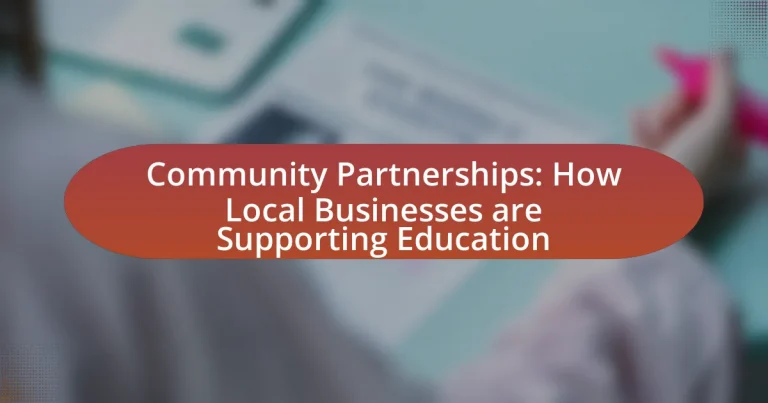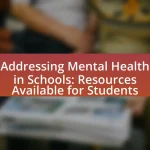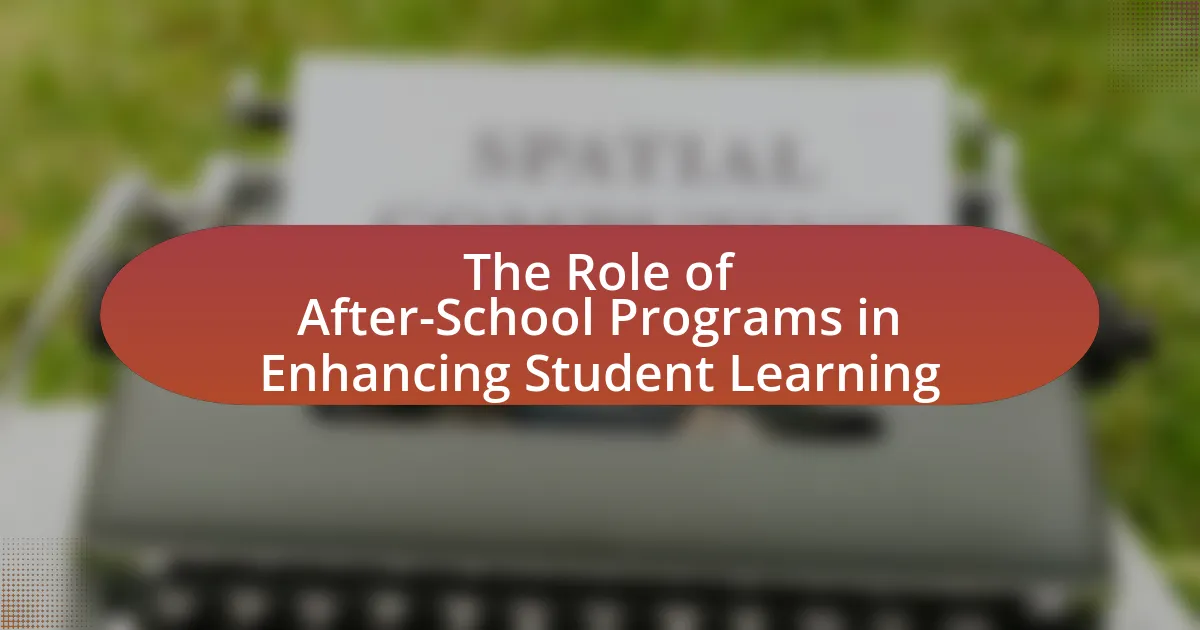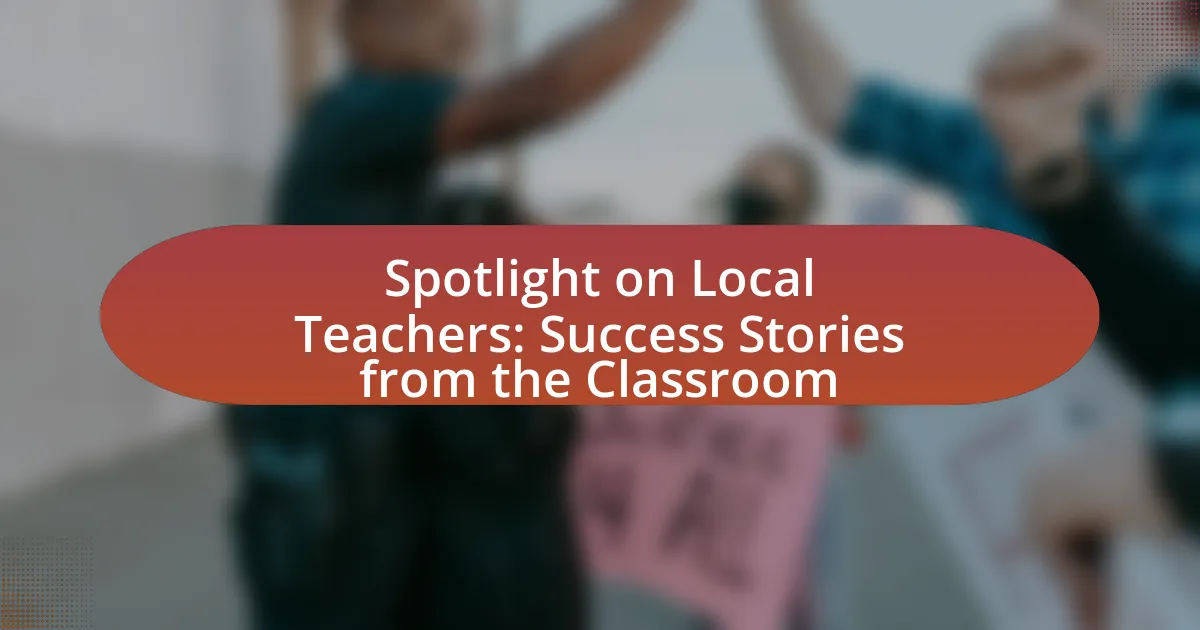Community partnerships in education refer to collaborative relationships between educational institutions and local businesses or organizations aimed at enhancing student learning and development. These partnerships provide essential resources, mentorship, and real-world experiences that improve student outcomes, as evidenced by various studies. Local businesses engage in these partnerships through sponsorships, internships, and curriculum development collaborations, which vary by community size and type. The article explores the importance of these partnerships, the benefits they offer to students, the challenges they face, and emerging trends in collaboration, highlighting the significant role local businesses play in supporting education and fostering community development.

What are Community Partnerships in Education?
Community partnerships in education are collaborative relationships between educational institutions and local organizations, businesses, or community groups aimed at enhancing student learning and development. These partnerships often provide resources, expertise, and support that schools may lack, such as mentorship programs, internships, and funding for educational initiatives. Research indicates that schools engaged in community partnerships can improve student outcomes, as evidenced by a study from the National Education Association, which found that schools with strong community ties see higher student achievement and engagement levels.
How do local businesses engage in community partnerships?
Local businesses engage in community partnerships by collaborating with educational institutions to support programs, initiatives, and resources that enhance learning experiences. These partnerships often involve sponsorship of school events, providing internships or job shadowing opportunities for students, and donating supplies or funding for educational projects. For instance, a study by the National Federation of Independent Business found that 70% of small businesses actively participate in local community initiatives, demonstrating their commitment to fostering educational growth and community development.
What types of partnerships exist between businesses and educational institutions?
Businesses and educational institutions engage in several types of partnerships, including internships, sponsorships, curriculum development collaborations, and research partnerships. Internships provide students with practical experience while allowing businesses to identify potential future employees. Sponsorships often involve financial support for educational programs or events, enhancing the institution’s resources. Curriculum development collaborations enable businesses to influence educational content, ensuring that it aligns with industry needs. Research partnerships allow both entities to work together on projects that can lead to innovation and advancements in their respective fields. These partnerships are essential for bridging the gap between education and industry, fostering workforce readiness and community development.
How do these partnerships vary by community size and type?
Partnerships between local businesses and educational institutions vary significantly by community size and type, with larger communities often having more formalized and diverse partnerships compared to smaller ones. In larger urban areas, businesses typically engage in structured programs, such as internships and mentorships, due to a greater availability of resources and a wider range of educational institutions. For example, a study by the National Center for Education Statistics found that urban schools are more likely to partner with businesses for career and technical education programs than rural schools. Conversely, smaller communities may rely on informal partnerships, where local businesses support schools through donations or sponsorships of events, reflecting a more personal and community-oriented approach. This difference is evident in the varying levels of engagement and types of support provided, with larger communities often facilitating more comprehensive initiatives that address a broader range of educational needs.
Why are community partnerships important for education?
Community partnerships are important for education because they enhance resources, support, and opportunities for students and schools. These collaborations provide access to funding, mentorship, and real-world experiences that enrich the educational environment. For instance, a study by the National Education Association found that schools with strong community partnerships report higher student achievement and engagement levels. Such partnerships also foster a sense of belonging and accountability, as local businesses and organizations become invested in the educational outcomes of their community.
What benefits do students gain from local business involvement?
Students gain practical experience and enhanced learning opportunities from local business involvement. This engagement allows students to apply classroom knowledge in real-world settings, fostering skills such as teamwork, communication, and problem-solving. For instance, partnerships with local businesses often lead to internships and mentorship programs, which have been shown to improve students’ career readiness. According to a study by the National Association of Colleges and Employers, 60% of employers prefer candidates with internship experience, highlighting the importance of such involvement in preparing students for the workforce. Additionally, local businesses can provide resources and funding for educational programs, further enriching the learning environment.
How do community partnerships enhance educational resources?
Community partnerships enhance educational resources by providing schools with additional funding, expertise, and materials that are often not available through traditional educational budgets. For instance, local businesses can sponsor programs, donate supplies, or offer internships, which directly enrich the learning experience for students. Research from the National Education Association indicates that schools with strong community partnerships report higher student engagement and improved academic performance, demonstrating the tangible benefits of these collaborations.
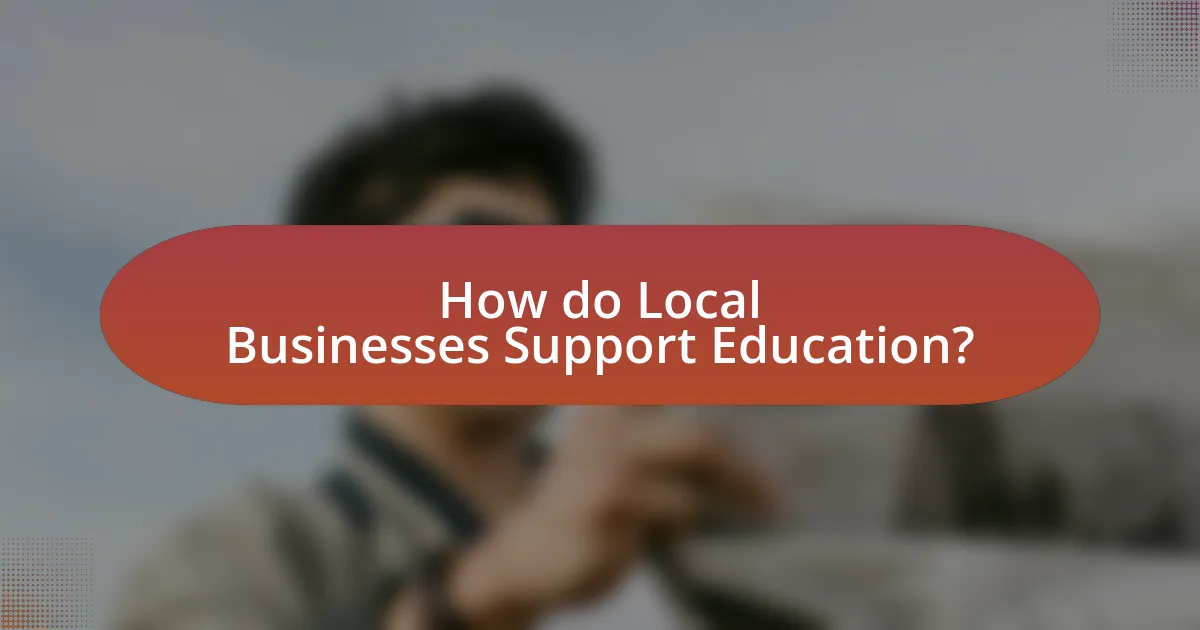
How do Local Businesses Support Education?
Local businesses support education by providing financial contributions, resources, and mentorship programs to schools and students. For instance, many local businesses sponsor scholarships, donate supplies, or fund extracurricular activities, which directly enhance educational opportunities. According to a report by the National School Foundation Association, local businesses contributed over $1 billion to public schools in the United States in 2020, demonstrating their significant role in supporting educational initiatives. Additionally, businesses often engage in mentorship programs, where employees volunteer their time to guide students, thereby fostering a connection between the community and educational institutions.
What specific initiatives do local businesses undertake to support schools?
Local businesses undertake various initiatives to support schools, including financial sponsorships, mentorship programs, and in-kind donations. For instance, many businesses provide scholarships for students, which directly contribute to educational advancement. Additionally, mentorship programs often involve employees volunteering their time to guide students, enhancing their career readiness. In-kind donations, such as supplies or equipment, help meet the immediate needs of schools, fostering a better learning environment. These initiatives not only benefit students but also strengthen community ties, demonstrating the commitment of local businesses to educational success.
How do businesses provide financial support to educational programs?
Businesses provide financial support to educational programs through direct funding, sponsorships, and grants. Many companies allocate a portion of their profits to support local schools and educational initiatives, often through corporate social responsibility (CSR) programs. For example, in 2020, businesses contributed over $1.5 billion to educational causes in the United States alone, demonstrating a significant commitment to enhancing educational opportunities. Additionally, businesses may sponsor specific programs or events, such as science fairs or scholarship funds, which directly benefit students and educational institutions. This financial backing not only aids in resource allocation but also fosters community engagement and development.
What role do businesses play in mentoring and internships for students?
Businesses play a crucial role in mentoring and internships for students by providing practical experience and guidance that enhances educational outcomes. Through structured internship programs, businesses offer students hands-on experience in real-world environments, allowing them to apply theoretical knowledge and develop essential skills. For instance, a study by the National Association of Colleges and Employers found that students who completed internships were 70% more likely to secure a job offer upon graduation compared to those who did not. Additionally, mentoring initiatives foster professional relationships, where experienced employees guide students, helping them navigate career paths and build networks. This collaboration between businesses and educational institutions ultimately prepares students for the workforce, bridging the gap between academic learning and industry requirements.
How do local businesses collaborate with educators?
Local businesses collaborate with educators through partnerships that enhance educational experiences and provide resources. These collaborations often include offering internships, sponsoring school events, and providing financial support for educational programs. For instance, a study by the National School Boards Association found that 70% of school districts reported partnerships with local businesses, which helped improve student engagement and learning outcomes. Additionally, businesses may contribute by supplying materials, mentoring students, or participating in career days, thereby fostering a mutually beneficial relationship that supports both education and community development.
What strategies do businesses use to align their support with educational goals?
Businesses align their support with educational goals through strategies such as partnerships with local schools, funding scholarships, and providing internships. These partnerships often involve collaborative programs that enhance curriculum relevance and offer real-world applications of academic concepts. For instance, businesses may sponsor STEM initiatives that directly support science and technology education, thereby fostering a skilled workforce. Additionally, funding scholarships helps to alleviate financial barriers for students pursuing higher education, which aligns with broader educational objectives of accessibility and equity. Providing internships allows students to gain practical experience, bridging the gap between education and employment, which is crucial for workforce readiness. These strategies not only support educational institutions but also contribute to community development and economic growth.
How can businesses and schools create effective communication channels?
Businesses and schools can create effective communication channels by establishing regular meetings and utilizing digital platforms for information sharing. Regular meetings, such as monthly check-ins or collaborative workshops, foster direct dialogue and relationship building between educators and business leaders. Digital platforms, including email newsletters, social media, and dedicated communication apps, facilitate timely updates and engagement, ensuring that both parties remain informed and connected. Research indicates that schools with strong community partnerships report higher student achievement and engagement, demonstrating the effectiveness of these communication strategies in enhancing educational outcomes.

What Challenges Do Community Partnerships Face?
Community partnerships face challenges such as misaligned goals, communication barriers, and resource limitations. Misaligned goals occur when partners have different objectives, leading to conflicts and inefficiencies. Communication barriers can hinder collaboration, as differing terminologies and expectations may create misunderstandings. Resource limitations, including funding and personnel, restrict the ability of partnerships to implement initiatives effectively. According to a study by the National Council of Nonprofits, 70% of partnerships struggle with these issues, impacting their overall effectiveness in supporting educational initiatives.
What obstacles hinder the effectiveness of community partnerships?
Obstacles that hinder the effectiveness of community partnerships include lack of communication, differing goals, and insufficient resources. Lack of communication can lead to misunderstandings and misalignment between partners, which diminishes collaboration. Differing goals among stakeholders can create conflicts, as each party may prioritize their own objectives over collective outcomes. Insufficient resources, such as funding or personnel, can limit the ability of partnerships to implement initiatives effectively. Research by the National Council of Nonprofits highlights that these factors significantly impact the sustainability and success of community partnerships in educational contexts.
How can businesses overcome barriers to engagement with schools?
Businesses can overcome barriers to engagement with schools by establishing clear communication channels and aligning their goals with educational objectives. Effective partnerships require businesses to actively listen to the needs of schools and tailor their support accordingly, such as providing resources, mentorship, or internships that directly benefit students. Research indicates that when businesses engage in collaborative programs, such as the Partnership for 21st Century Skills, they enhance student learning outcomes and foster a more skilled workforce. By prioritizing mutual benefits and maintaining ongoing dialogue, businesses can create sustainable relationships that bridge the gap between the corporate and educational sectors.
What are common misconceptions about business involvement in education?
Common misconceptions about business involvement in education include the belief that businesses primarily seek profit at the expense of educational quality and that their involvement undermines the role of educators. In reality, many businesses engage in education to foster community development and workforce readiness, recognizing that a well-educated population benefits their future workforce and local economy. For instance, a report by the Business-Higher Education Forum indicates that 80% of business leaders believe partnerships with educational institutions enhance student outcomes and prepare them for the workforce. Additionally, businesses often provide resources, mentorship, and real-world experiences that complement traditional education, rather than replace or diminish the role of teachers.
How can community partnerships be improved?
Community partnerships can be improved by fostering open communication and collaboration between local businesses and educational institutions. Establishing regular meetings and feedback mechanisms allows both parties to align their goals and resources effectively. Research indicates that partnerships with clear objectives and mutual benefits lead to more successful outcomes; for instance, a study by the National Center for Education Statistics found that schools with active business partnerships reported higher student engagement and achievement. By prioritizing transparency and shared objectives, community partnerships can enhance their impact on education.
What best practices can businesses adopt to enhance their educational support?
Businesses can enhance their educational support by establishing partnerships with local schools and educational organizations. These partnerships can include providing resources such as funding, materials, and mentorship programs, which have been shown to improve student outcomes. For instance, a study by the National Education Association found that businesses that engage in community partnerships can significantly increase student engagement and academic performance. Additionally, offering internships and job shadowing opportunities allows students to gain real-world experience, further bridging the gap between education and employment. By actively participating in educational initiatives, businesses not only contribute to community development but also foster a skilled future workforce.
How can schools better leverage local business resources for student success?
Schools can better leverage local business resources for student success by establishing structured partnerships that facilitate internships, mentorship programs, and resource sharing. These partnerships enable students to gain real-world experience and skills that align with local industry needs. For instance, a study by the National Center for Education Statistics found that students who participate in internships are 30% more likely to secure employment after graduation. Additionally, local businesses can provide financial support, materials, and expertise, enhancing educational programs and creating a more relevant curriculum. By actively engaging with local businesses, schools can create a mutually beneficial ecosystem that promotes student achievement and community development.
What are the Future Trends in Community Partnerships for Education?
Future trends in community partnerships for education include increased collaboration between local businesses and schools, a focus on experiential learning opportunities, and the integration of technology in educational initiatives. These partnerships are evolving to address skills gaps in the workforce by providing students with real-world experiences and mentorship. For instance, according to a report by the U.S. Chamber of Commerce Foundation, 70% of employers believe that partnerships with educational institutions are essential for developing a skilled workforce. Additionally, businesses are increasingly investing in programs that promote STEM education, reflecting the growing demand for skills in science, technology, engineering, and mathematics. This trend indicates a shift towards more strategic alliances that benefit both students and local economies.
How is technology influencing community partnerships in education?
Technology is significantly enhancing community partnerships in education by facilitating communication and collaboration between schools and local businesses. Digital platforms enable real-time sharing of resources, information, and opportunities, allowing businesses to engage with educational institutions more effectively. For instance, tools like video conferencing and collaborative software allow for virtual mentorship programs and workshops, which have been shown to increase student engagement and provide practical learning experiences. According to a report by the U.S. Department of Education, schools that leverage technology for community partnerships report improved student outcomes and stronger ties with local businesses, demonstrating the positive impact of technology on educational collaboration.
What emerging models of collaboration are being developed?
Emerging models of collaboration being developed include public-private partnerships, where local businesses collaborate with educational institutions to enhance learning experiences. These partnerships often involve businesses providing resources, mentorship, and real-world projects that align with educational curricula. For instance, initiatives like the “Business-Education Partnership” model have shown success in various regions, facilitating internships and job shadowing opportunities for students, thereby bridging the gap between education and workforce needs. Research indicates that such collaborations can lead to improved student outcomes and increased community engagement, as evidenced by studies from the National Alliance for Partnerships in Equity, which highlight the positive impact of these models on both students and local economies.
What practical steps can local businesses take to support education effectively?
Local businesses can support education effectively by establishing partnerships with schools to provide resources, mentorship, and funding. For instance, businesses can donate supplies or technology, which directly enhances the learning environment. According to a study by the National School Supply and Equipment Association, 94% of teachers spend their own money on classroom supplies, highlighting the need for external support. Additionally, businesses can offer internships or job shadowing opportunities, which help students gain real-world experience and skills. Research from the Partnership for 21st Century Learning indicates that such experiential learning significantly improves student engagement and career readiness. Furthermore, local businesses can sponsor educational events or programs, fostering community involvement and investment in local education.
